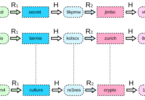In the ever-evolving landscape of technology, the symbiotic relationship between Artificial Intelligence (AI) and cybersecurity has become increasingly crucial. As we navigate the digital age, the utilization of AI applications in the realm of cybersecurity has proven to be a game-changer, addressing complex challenges and presenting innovative solutions. Unraveling the fascinating tapestry of AI applications in cybersecurity reveals not only the promises of enhanced protection but also a landscape where the boundaries between defender and attacker are blurred. Here are some intriguing facts that shed light on the symbiosis between AI and cybersecurity.
The Rise of Adversarial AI in Cybersecurity
One of the lesser-known aspects of AI applications in cybersecurity is the emergence of adversarial AI, a phenomenon where artificial intelligence is turned against itself. Cyber attackers, equipped with sophisticated tools, are increasingly leveraging AI to identify vulnerabilities and exploit them. The cat-and-mouse game between security systems and malicious actors has reached new heights with adversarial AI. This entails attackers using machine learning algorithms to study and manipulate the defensive algorithms employed by cybersecurity systems. In essence, AI is being weaponized on both sides of the cybersecurity battlefield, resulting in a perpetual cycle of innovation and counteraction. This dynamic landscape underscores the need for cybersecurity professionals to not only harness the power of AI for defense but also anticipate and counter the malicious use of AI by adversaries.
The Role of AI in Autonomous Cyber Defense
In a bid to counter the speed and sophistication of cyber threats, AI has taken on an increasingly autonomous role in cybersecurity. Autonomous cyber defense systems leverage AI algorithms to detect and respond to threats in real-time, often without direct human intervention. These systems can analyze vast amounts of data, identify patterns, and make split-second decisions to mitigate potential risks. The autonomous nature of these AI-driven defenses allows for rapid response times, crucial in an era where cyber threats can evolve at an unprecedented pace. However, the reliance on AI for autonomous defense also introduces new challenges, such as the potential for false positives and the ethical implications of allowing AI systems to make critical decisions. Striking the right balance between human oversight and AI autonomy remains a key challenge in the pursuit of effective cybersecurity.
Ethical Considerations and Bias in AI-Powered Cybersecurity
As AI becomes more integral to cybersecurity, ethical considerations come to the forefront, particularly concerning biases embedded in machine learning algorithms. AI systems learn from historical data, and if this data is biased, the AI may perpetuate and even exacerbate existing prejudices. In the realm of cybersecurity, biased algorithms could lead to discriminatory practices, unfairly targeting specific groups or demographics. Moreover, the opacity of some AI models adds a layer of complexity, making it challenging to understand and rectify biases. Addressing these ethical considerations requires a concerted effort from cybersecurity professionals, data scientists, and policymakers to ensure that AI-powered cybersecurity solutions are not only effective but also aligned with ethical standards. Striving for transparency, accountability, and continuous scrutiny of AI models is imperative to build trust and mitigate potential risks associated with biased algorithms.
Third-Party Validation
In the burgeoning realm of AI applications, where innovation is prolific, the credibility of AI-generated results becomes a paramount concern. To bolster trust in the efficacy of AI in cybersecurity, companies are increasingly turning to third-party validation and testing services. As explained by experts from fortifai.org, these entities play a crucial role in independently assessing and verifying the claims made by AI innovations in the cybersecurity space. By subjecting AI systems to rigorous testing methodologies, these companies contribute to a higher level of transparency and accountability. Ensuring the safety and security of AI-generated results becomes a collaborative effort, with external validation offering an unbiased evaluation of the capabilities and limitations of AI-powered cybersecurity solutions. As the stakes rise in the digital arms race, the role of third-party validation becomes instrumental in building trust among stakeholders and fortifying the foundations of AI-driven cybersecurity.
Landscape of Cyber Threats and Adaptive AI Defense
The landscape of cyber threats is in constant flux, with attackers employing increasingly sophisticated tactics. In response, AI-driven cybersecurity is evolving to become more adaptive and resilient. The application of machine learning in threat detection allows AI systems to learn from new data and adapt to emerging threat vectors. This adaptability is essential in an environment where cyber threats are not static but dynamic and continually evolving. By harnessing the power of AI to predict and counteract novel threats, cybersecurity professionals can stay one step ahead in the ongoing battle against cyber adversaries. As the arms race between attackers and defenders intensifies, the ability of AI to adapt and learn in real time becomes a pivotal factor in maintaining the security of digital ecosystems.
Collaborative Efforts in AI and Cybersecurity Research
The intersection of AI and cybersecurity thrives on collaborative efforts among researchers, industry experts, and policymakers. Open dialogues and shared research contribute to a collective understanding of the challenges and opportunities in this space. Collaborations foster the development of standardized practices, ethical frameworks, and guidelines for the responsible deployment of AI in cybersecurity. Furthermore, joint research initiatives allow for the pooling of resources and expertise, accelerating the pace of innovation. In a world where cyber threats respect no borders, collaborative efforts are vital to creating a robust defense against global challenges. The synergy between AI and cybersecurity is strengthened by the collective wisdom of those committed to advancing technology for the benefit of all.
In the intricate dance of AI and cybersecurity, the intertwining threads of innovation, challenges, and collaboration weave a complex tapestry. As AI applications continue to shape the landscape of cybersecurity, staying informed about adversarial AI, autonomous defense, ethical considerations, third-party validation, and collaborative research is paramount. Navigating this complex tapestry requires a holistic approach that balances innovation with accountability and adaptability with ethical considerations. As we navigate the future intersection of AI and cybersecurity, it is the collective responsibility of the global community to foster an environment where the promises of AI are realized while ensuring the safety, security, and ethical use of these powerful technologies.







